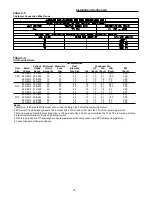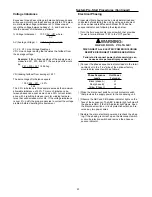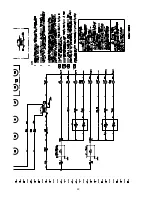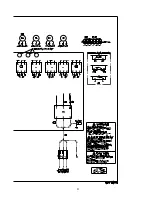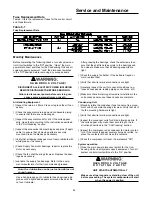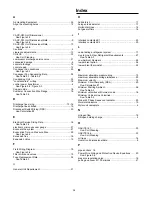
21
System Pre-Start Procedures
and suction line access valve). Follow the pump
manufacturer’s directions for the proper methods of using
the vacuum pump.
The lines used to connect the pump to the system should
be copper and of the largest diameter that can practically
be used. Using larger line sizes with minimum flow resis-
tance can significantly reduce evacuation time. Rubber or
synthetic hoses are not recommended for system evacua-
tion because they have moisture absorbing characteristics
which result in excessive rates of evaporation, causing
pressure rise during the standing vacuum test. This makes
it impossible to determine if the system has a leak, exces-
sive residual moisture, or a continual or high rate of pres-
sure increase due to the hoses.
An electronic micron vacuum gauge should be installed in
the common line ahead of the vacuum pump shutoff valve,
as shown in
Figure 4-1. Close Valves B and C, and open
Valve A.
Start the vacuum pump, after several minutes, the gauge
reading will indicate the maximum vacuum the pump is ca-
pable of pulling. Rotary pumps should produce vacuums of
100 microns or less.
Note: Do not, under any circumstances, use a
megohm meter or apply power to the windings of a
compressor while it is under a vacuum. Electrical
shorting between motor windings and/or housing
can occur while in a vacuum, causing motor
burnout.
Open Valves B and C. Evacuate the system to a pressure
of 300 microns or less. As the vacuum is being pulled on
the system, there could be a time when it would appear that
no further vacuum is being obtained, yet, the pressure is
high. It is recommended that during the evacuation process,
the vacuum be “Broken”, to facilitate the evacuation pro-
cess.
To break the vacuum;
Shutoff valves A, B, & C and connect a refrigerant
cylinder to the charging port on the manifold. Purge
the air form the hose. Raise the standing vacuum
pressure in the system to “zero” (0 psig) gauge
pressure. Repeat this process two or three times
during evacuation.
Note: It is unlawful to release refrigerant into the
atmosphere. When service procedures require
working with refrigerants, the service technician
must comply with all Federal, State, and local laws.
Refer to the General Service Bulletin MSCU-SB-1
(latest edition).
Standing Vacuum Test
Once 300 microns or less is obtained, close Valve A and
leave valves B and C open. This will allow the vacuum
gauge to read the actual system pressure. Let the system
equalize for approximately 15 minutes. This is referred to as
a “standing vacuum test” where, time versus pressure rise.
The maximum allowable rise over a 15 minute period is 200
microns. If the pressure rise is greater than 200 microns but
levels off to a constant value, excessive moisture is
present. If the pressure steadily continues to rise, a leak is
indicated. Figure 4-2 illustrates three possible results of the
“standing vacuum test”.
Use the checklist provided below in conjunction with the
“General Unit Requirement” checklist” to ensure that the
unit is properly installed and ready for operation. Be sure to
complete all of the procedures described in this section be-
fore starting the unit for the first time.
[ ] Turn the field supplied disconnect switch, located up-
stream of the unit, to the “Off” position.
H A Z A R D O U S V O LTA G E !
DISCONNECT ALL ELECTRIC POWER INCLUDING
REMOTE DISCONNECTS BEFORE SERVICING.
Failure to disconnect power before servicing can
cause severe personal injury or death.
[ ] Turn the “System” selection switch (at the Remote Panel)
to the “Off” position and the “Fan” selection switch (if Ap-
plicable) to the “Auto” or “Off” position.
[ ] Check all electrical connections for tightness and “point
of termination” accuracy.
[ ] Verify that the condenser airflow will be unobstructed.
[ ] Check the condenser fan blades. Ensure they rotate
freely within the fan orifices and are securely fastened to
the fan motor shaft.
[ ] Verify that all compressor service valves, discharge ser-
vice valves, and liquid line service valves are back
seated on each circuit.
COMPRESSOR SERVICE VALVES!
COMPRESSOR SERVICE VALVES MUST BE FULLY
OPENED BEFORE START-UP (SUCTION, DIS-
CHARGE, LIQUID LINE, AND OIL LINE).
Failure to fully open valves prior to start-up may
cause compressor failure due to lack of refrigerant
and/or oil flow.
[ ] Inspect the interior of the unit for tools and debris.
System Evacuation Procedures
Each refrigeration circuit for split system applications must
be evacuated before the unit can be started. Use a rotary
type vacuum pump capable of pulling a vacuum of 100 mi-
crons or less. Verify that the unit disconnect switch and the
system control circuit switches are “OFF”.
The oil in the vacuum pump should be changed each time
the pump is used with a high quality vacuum pump oil. Be-
fore using any oil, check the oil container for discoloration
which usually indicates moisture in the oil and/or water
droplets. Moisture in the oil adds to what the pump has to
remove from the system, making the pump inefficient.
When connecting the vacuum pump to a refrigeration sys-
tem, it is important to manifold the vacuum pump to both
the high and low side of the system (liquid line access valve
Summary of Contents for CAUC-C80
Page 8: ...8 Figure 3 2 CAUC C80 Unit Dimensional Data Recommended Clearances ...
Page 9: ...9 Figure 3 2 Continued CAUC D10 Unit Dimensional Data Recommended Clearances ...
Page 10: ...10 Figure 3 2 Continued CAUC D12 Unit Dimensional Data Recommended Clearances ...
Page 19: ...19 Installation Continued Figure 3 5 Typical CAUC C80 through D12 Field Wiring Diagram ...
Page 28: ...28 Figure 5 2 Typical Wiring Schematic for 80 through 120 Ton Units ...
Page 29: ...29 ...
Page 30: ...30 Figure 5 3 Typical Control Panel Connections Diagram for 80 through 120 Ton Units ...
Page 31: ...31 ...
Page 36: ...36 ...












